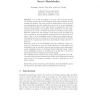Free Online Productivity Tools
i2Speak
i2Symbol
i2OCR
iTex2Img
iWeb2Print
iWeb2Shot
i2Type
iPdf2Split
iPdf2Merge
i2Bopomofo
i2Arabic
i2Style
i2Image
i2PDF
iLatex2Rtf
Sci2ools
ACNS
2006
Springer
2006
Springer
Authentication for Paranoids: Multi-party Secret Handshakes
In a society increasingly concerned with the steady assault on electronic privacy, the need for privacy-preserving techniques is both natural and justified. This need extends to traditional security tools such as authentication and key distribution protocols. A secret handshake protocol allow members of the same group to authenticate each other secretly, meaning that a non-member cannot determine, even by engaging someone in a protocol, whether that party is a member of the group. Whereas, parties who are members of the same group recognize each other as members, and can establish authenticated secret keys with each other. Thus, a secret handshake protocol offers privacy-preserving authentication and can be used whenever group members need to identify and securely communicate with each other without being observed or detected. Most prior work in secret handshake protocols considered 2-party scenarios. In this paper we propose formal definitions of multi-party secret handshakes, and ...
ACNS 2006 | Cryptography | Handshake Protocol Offers | Multi-party Secret Handshake | Secret Handshake Protocol |
| Added | 13 Jun 2010 |
| Updated | 13 Jun 2010 |
| Type | Conference |
| Year | 2006 |
| Where | ACNS |
| Authors | Stanislaw Jarecki, Jihye Kim, Gene Tsudik |
Comments (0)

